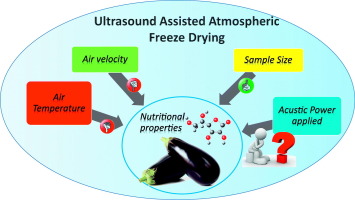Food Research International ( IF 8.1 ) Pub Date : 2018-01-12 , DOI: 10.1016/j.foodres.2018.01.022 Domenico Colucci , Davide Fissore , Carmen Rossello , Juan A. Carcel

|
The low operating temperatures employed in atmospheric freeze-drying permits an effective drying of heat sensitive products, without any impairment of their quality attributes. When using power ultrasound, the drying rate can be increased, thus reducing the process duration. However, ultrasound can also affect the product quality. The aim of this study was to evaluate the effect of various drying process variables, namely air temperature and velocity, ultrasound power and sample size, on the antioxidant properties of eggplant (Solanum melongena L.) samples. For this reason, drying experiments were carried out at different drying temperatures (−5, −7.5, −10 °C), power ultrasound levels (0, 25, 50 W; 21.9 kHz) and air velocities (2, 5 m s−1) using different sample sizes (8.8 mm and 17.6 mm cube side). The ascorbic acid content (Jagota and Dani method), total phenolic content (Folin-Ciocalteau method), and the antioxidant capacity (FRAP method) of the dried products were considered as quality indicators of the dried samples. The increase in air velocity and temperature, as well as the sample size, significantly reduced the antioxidant potential of the dried samples (p-value < .05). For a given sample size, the application of ultrasound, at the acoustic power levels tested, did not produce significant effects on the antioxidant indicators considered. Temperature measurements inside the drying sample showed a non-negligible temperature rise when acoustic power was applied.
中文翻译:

超声波辅助大气冷冻干燥对茄子抗氧化性能的影响
大气冷冻干燥中使用的低操作温度允许对热敏产品进行有效干燥,而不会损害其质量属性。使用功率超声时,可以提高干燥速度,从而缩短了处理时间。但是,超声波也会影响产品质量。这项研究的目的是评估各种干燥过程变量,例如空气温度和速度,超声功率和样品量,对茄子(Solanum melongena L.)样品的抗氧化性能的影响。因此,在不同的干燥温度(-5,-7.5,-10°C),功率超声水平(0、25、50 W; 21.9 kHz)和空气流速(2、5 m s -1)下进行干燥实验),使用不同的样本大小(8.8毫米和17.6毫米立方体边)。干燥产物的抗坏血酸含量(Jagota和Dani方法),总酚含量(Folin-Ciocalteau方法)和抗氧化能力(FRAP方法)被认为是干燥样品的质量指标。空气速度和温度的提高以及样品的大小显着降低了干燥样品的抗氧化能力(p值<.05)。对于给定的样本量,在测试的声功率水平下,超声的应用不会对所考虑的抗氧化剂指标产生显着影响。干燥样品内部的温度测量结果表明,施加声功率时,温度升高不可忽略。



























 京公网安备 11010802027423号
京公网安备 11010802027423号